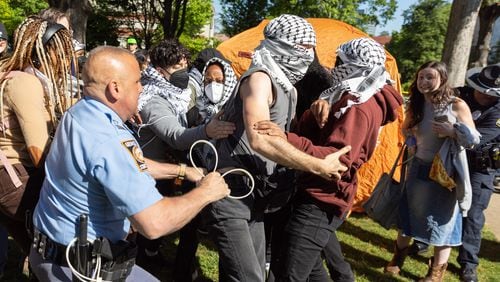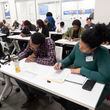Early in the school year, David Hale and a few of his classmates huddled in a corner of Room 306 at Druid Hills High School and slowly began constructing the story behind a Wal-Mart store receipt.
The purchases, made on Dec. 10, 2008, included a DVD, washcloths and bath towels, eggnog and an infant car seat among other things.
Based on the items, those in Hale’s group believed the purchase was for a family who’d just had a baby and was moving into a new home.
It was the kind of exercise that pushed students to think far beyond the cold hard facts, to test their theory against the evidence and, right or wrong, draw a conclusion.
Vincent Gray is the teacher you hope is before every classroom and most assuredly in every school.
“Mr. Gray showed us what it’s like to be a historian,” Hale said, “how you get evidence and have to build a story around it based purely on the evidence.”
I met Gray, 35, the other day in the teachers’ lounge at Druid Hills, where he has been introducing his students to this rudiment for the past six years.
From what I’ve heard about him, he’s everything a teacher should be: inspiring, passionate, provocative.
The kind of teacher who doesn’t just help you do better on standardized tests but one you remember long into adulthood because he awakened in you the art of the question, the one thing all great teachers do.
I imagine there are many more, in school districts across metro Atlanta, whose names I could substitute here, but sometimes a teacher so impresses upon his students to think critically about what they learn — to use evidence to investigate a point of view or reach a conclusion — you hear about him from a parent, a student or both.
“Mr. Gray impresses me as the ultimate kind of teacher who provokes students into thinking,” said Angela Hale, David’s mom. “He gets the students to dig much deeper. Beyond challenging their own assumptions — he gets them to develop their own questions.
“If a textbook suggests answers to questions, then Mr. Gray demonstrates that even the questions are generated from a bias — and that the students should formulate their own questions.”
Gray began teaching at Druid Hills in 2009, shortly after earning a master's in education at Georgia State University.
By then, he was already in love with the DeKalb County school. It was where he’d done his student teaching, where he discovered education — not lawyering as he first thought — was his calling.
He fulfills that calling five days a week, teaching 11th-graders U.S. history, including Advanced Placement courses.
“I take the approach that history is a constructive process, not something to be memorized,” he said. “In order to teach kids the importance of what historians do, they need to grapple with the raw materials of history — leftover documents and artifacts.”
What they construct, however, depends on not only how they use that information but the lens through which they view it. At Druid Hills, that could be black, white, Hispanic or Asian. Rich, middle-class or poor. Speak English or one of 15 other languages.
Either way, Gray knows that memorizing historical facts can be useful, but it’s more important to teach kids to think critically about those facts.
Hence the Wal-Mart receipt, an idea he borrowed from a woman he met at the Atlanta History Center and introduced to his students during the first weeks of school.
Students were arranged in groups and then asked to reconstruct a story based on the recorded purchases. The stories were as varied as the students themselves, but there was just one goal: to get students to think critically about their world and how they know what they know from the past.
Gray uses other tools to get his students to think outside the box as well.
In another exercise, he asked them to imagine they are 10,000 years in the future and find a penny, nickel, dime and quarter. If they had to figure out who were these people and from what civilization they came, could they reconstruct the past and figure out what this country was about?
Why are there only men on the coins? Was this a male-dominated society? Does the inscription “In God We Trust” indicate it was a religious society?
“Everyone has their interpretation of the past,” Gray said. “The harder question is how your perspective or bias is influencing that interpretation.”
In other words, there’s no such thing as facts standing on their own. How we see them depends on our life experiences and our willingness to be honest and think critically about them.
Good teachers know that. Good students learn from it.
About the Author






